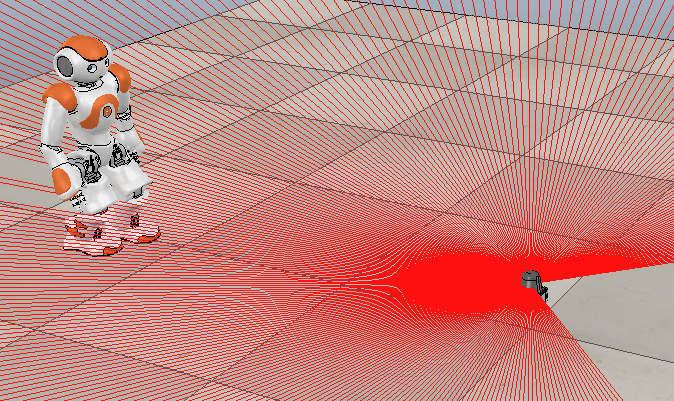VREP中的二維激光雷達
目前,輪式機器人的研究中已經大量使用激光雷達輔助機器人的避障導航,考慮到使用成本,一般二維激光雷達使用較多,如下圖。由於只能掃描一個平面,如果想用二維激光雷達獲取環境三維點雲,則需要通過移動機器人或加裝機械結構提供第三個維度的支持。


激光雷達通常有四個性能衡量指標:測距分辨率、掃描頻率(有時也用掃描周期)、角度分辨率及可視範圍。測距分辨率衡量在一個給定的距離下測距的精確程度,通常與距離真實值相差在5-20mm;掃描頻率衡量激光雷達完成一次完整掃描的快慢,通常在10Hz及以上;角度分辨率直接決定激光雷達一次完整掃描能返回多少個樣本點;可視範圍指激光雷達完整掃描的廣角,可視範圍之外即為盲區。
- 使用視覺傳感器模擬激光雷達
為了模擬二維激光雷達,將視覺傳感器設為透視模型並只獲取深度信息。near clipping plane和far clipping plane設置為激光雷達的最小/最大掃描距離;視場角Persp. angle設為雷達可視範圍(角度);將Y軸分辨力率設為1,X軸分辨率可根據需求設置(分辨率越大結果越精確,分辨率過低可能會造成某些尺寸小的物體無法被探測到)。
 視覺傳感器filter設置如下,其中加入Extract coordinates from work image用來提取深度圖像中坐標信息,這一環節返回的數據可以通過函數simReadVisionSensor來獲取。參數設置界面上的Point count along X/Y設為X/Y軸分辨率,即調用一次相關API函數可以讀取包含256個像素點的坐標信息的數據:
視覺傳感器filter設置如下,其中加入Extract coordinates from work image用來提取深度圖像中坐標信息,這一環節返回的數據可以通過函數simReadVisionSensor來獲取。參數設置界面上的Point count along X/Y設為X/Y軸分辨率,即調用一次相關API函數可以讀取包含256個像素點的坐標信息的數據:

為了顯示激光雷達“看到”的環境,可以通過Graph來記錄用戶自定義數據流:按照下圖所示在數據類型欄中選擇user-defined,將自定義數據名分別修改為"x"和"y"用來記錄障礙物相對於激光雷達的位置,並通過函數simSetGraphUserData

Graph:

if (sim_call_type==sim_childscriptcall_initialization) then -- Put some initialization code here graphHandle = simGetObjectAssociatedWithScript(sim_handle_self) end if (sim_call_type==sim_childscriptcall_sensing) then -- Put your main SENSING code here simResetGraph(graphHandle) data = simGetStringSignal("UserData") if data then measuredData = simUnpackFloatTable(data) for i=1,#measuredData/2,1 do simSetGraphUserData(graphHandle,‘x‘,measuredData[2*(i-1)+1]) simSetGraphUserData(graphHandle,‘y‘,measuredData[2*(i-1)+2]) simHandleGraph(graphHandle,0) end end end if (sim_call_type==sim_childscriptcall_cleanup) then -- Put some restoration code here simResetGraph(graphHandle) end --[[ Normally, simHandleGraph is called for you, in the main script. In that case, you can record one value in each simulation step. When you explicitely handle the graph, then you have the possibility to record more than one new graph point in each simulation step. --]]View Code
Vision_sensor:

if (sim_call_type==sim_childscriptcall_initialization) then -- Put some initialization code here visionSensor1Handle = simGetObjectHandle("Vision_sensor") red={1,0,0} points=simAddDrawingObject(sim_drawing_points,5,0,-1,1000,red,nil,red,red) end if (sim_call_type==sim_childscriptcall_sensing) then -- Put your main SENSING code here measureData = {} m1=simGetObjectMatrix(visionSensor1Handle,-1) r,t1,u1=simReadVisionSensor(visionSensor1Handle) if u1 then for j=0,u1[2]-1,1 do -- point count along Y for i=0,u1[1]-1,1 do -- point count along X w=2+4*(j*u1[1]+i) -- index v1=u1[w+1] -- x v2=u1[w+2] -- y v3=u1[w+3] -- z v4=u1[w+4] -- dist if(v4 < 0.99) then --[[ p={v1,v2,v3} p=simMultiplyVector(m1,p) -- convert point from visionSensor1 coordinates to world coordinates simAddDrawingObjectItem(points, p) --]] table.insert(measureData, v1) table.insert(measureData, v3) end end end stringData = simPackFloats(measureData) -- Packs a table of floating-point numbers into a string simSetStringSignal("UserData", stringData) end end if (sim_call_type==sim_childscriptcall_cleanup) then -- Put some restoration code here simRemoveDrawingObject(points) endView Code
在場景中加入浮動窗口,並將Graph與窗口關聯,切換到X-Y曲線顯示(取消坐標軸自動縮放,坐標軸比例設為1:1)

- SICK TiM310
VREP模型瀏覽器的components/sensors目錄中包含多種激光雷達,其中德國SICK傳感器推出的迷你激光測量系統TiM310可視範圍為270°,角度分辨率為1°,探測距離為0.05m~4m,掃描頻率15Hz,功耗4W。

operating range diagram
由於是用視覺傳感器來模擬激光雷達,因此270°的可視範圍對於一般視覺傳感器來說太大(普通廣角鏡頭視角在60-84度,超廣角鏡頭的視角為94-118度,魚眼鏡頭視角在220-230度),可以拆分為2個視角135°的視覺傳感器來湊成270°:

視角參數和遠近剪切平面設置如下:

激光雷達獲取的位置數據要在參考坐標系SICK_TiM310_ref中描述,而simReadVisionSensor獲取的像素點坐標是相對於視覺傳感器坐標系的,因此需要使用矩陣變換將其轉換到SICK_TiM310_ref參考系中。用畫筆在場景中畫出激光雷達的掃描線,需要得知線段起點和終點坐標,這一坐標是在世界坐標系下描述的,因此一共涉及3個坐標系之間的變換。

if (sim_call_type==sim_childscriptcall_initialization) then visionSensor1Handle=simGetObjectHandle("SICK_TiM310_sensor1") visionSensor2Handle=simGetObjectHandle("SICK_TiM310_sensor2") joint1Handle=simGetObjectHandle("SICK_TiM310_joint1") joint2Handle=simGetObjectHandle("SICK_TiM310_joint2") sensorRefHandle=simGetObjectHandle("SICK_TiM310_ref") -- the base of SICK LiDAR maxScanDistance=simGetScriptSimulationParameter(sim_handle_self,‘maxScanDistance‘) if maxScanDistance>1000 then maxScanDistance=1000 end if maxScanDistance<0.1 then maxScanDistance=0.1 end simSetObjectFloatParameter(visionSensor1Handle,sim_visionfloatparam_far_clipping,maxScanDistance) simSetObjectFloatParameter(visionSensor2Handle,sim_visionfloatparam_far_clipping,maxScanDistance) maxScanDistance_=maxScanDistance*0.9999 scanningAngle=simGetScriptSimulationParameter(sim_handle_self,‘scanAngle‘) if scanningAngle>270 then scanningAngle=270 end if scanningAngle<2 then scanningAngle=2 end scanningAngle=scanningAngle*math.pi/180 simSetObjectFloatParameter(visionSensor1Handle,sim_visionfloatparam_perspective_angle,scanningAngle/2) simSetObjectFloatParameter(visionSensor2Handle,sim_visionfloatparam_perspective_angle,scanningAngle/2) simSetJointPosition(joint1Handle,-scanningAngle/4) simSetJointPosition(joint2Handle,scanningAngle/4) red={1,0,0} lines=simAddDrawingObject(sim_drawing_lines,1,0,-1,1000,nil,nil,nil,red) if (simGetInt32Parameter(sim_intparam_program_version)<30004) then simDisplayDialog("ERROR","This version of the SICK sensor is only supported from V-REP V3.0.4 and upwards.&&nMake sure to update your V-REP.",sim_dlgstyle_ok,false,nil,{0.8,0,0,0,0,0},{0.5,0,0,1,1,1}) end end if (sim_call_type==sim_childscriptcall_cleanup) then simRemoveDrawingObject(lines) end if (sim_call_type==sim_childscriptcall_sensing) then measuredData={} if notFirstHere then -- We skip the very first reading simAddDrawingObjectItem(lines,nil) showLines=simGetScriptSimulationParameter(sim_handle_self,‘showLaserSegments‘) r,t1,u1=simReadVisionSensor(visionSensor1Handle) r,t2,u2=simReadVisionSensor(visionSensor2Handle) m1=simGetObjectMatrix(visionSensor1Handle,-1) m01=simGetInvertedMatrix(simGetObjectMatrix(sensorRefHandle,-1)) m01=simMultiplyMatrices(m01,m1) -- transformation matrix between base and visionSensor m2=simGetObjectMatrix(visionSensor2Handle,-1) m02=simGetInvertedMatrix(simGetObjectMatrix(sensorRefHandle,-1)) m02=simMultiplyMatrices(m02,m2) if u1 then p={0,0,0} p=simMultiplyVector(m1,p) -- convert the origin of visionSensor1 coordinates to world coordinates t={p[1],p[2],p[3],0,0,0} for j=0,u1[2]-1,1 do -- point count along Y for i=0,u1[1]-1,1 do -- point count along X w=2+4*(j*u1[1]+i) -- index v1=u1[w+1] -- coordinate x of detected point(Coordinates are relative to the vision sensor position/orientation.) v2=u1[w+2] -- coordinate y of detected point v3=u1[w+3] -- coordinate z of detected point v4=u1[w+4] -- distance to detected point if (v4<maxScanDistance_) then p={v1,v2,v3} p=simMultiplyVector(m01,p) -- describe position in LiDAR base coordinates table.insert(measuredData,p[1]) table.insert(measuredData,p[2]) table.insert(measuredData,p[3]) end if showLines then -- draw laser line p={v1,v2,v3} p=simMultiplyVector(m1,p) -- convert point from visionSensor1 coordinates to world coordinates t[4]=p[1] t[5]=p[2] t[6]=p[3] simAddDrawingObjectItem(lines,t) end end end end if u2 then p={0,0,0} p=simMultiplyVector(m2,p) t={p[1],p[2],p[3],0,0,0} for j=0,u2[2]-1,1 do for i=0,u2[1]-1,1 do w=2+4*(j*u2[1]+i) v1=u2[w+1] v2=u2[w+2] v3=u2[w+3] v4=u2[w+4] if (v4<maxScanDistance_) then p={v1,v2,v3} p=simMultiplyVector(m02,p) table.insert(measuredData,p[1]) table.insert(measuredData,p[2]) table.insert(measuredData,p[3]) end if showLines then p={v1,v2,v3} p=simMultiplyVector(m2,p) t[4]=p[1] t[5]=p[2] t[6]=p[3] simAddDrawingObjectItem(lines,t) end end end end end notFirstHere=true -- measuredData now contains all the points that are closer than the sensor range -- For each point there is the x, y and z coordinate (i.e. 3 number for each point) -- Coordinates are expressed relative to the sensor frame. -- You can access this data from outside via various mechanisms. The best is to first -- pack the data, then to send it as a string. For example: -- -- -- data=simPackFloatTable(measuredData) -- simSetStringSignal("measuredDataAtThisTime",data) -- -- Then in a different location: -- data=simGetStringSignal("measuredDataAtThisTime") -- measuredData=simUnpackFloatTable(data) -- -- -- Of course you can also send the data via tubes, wireless (simTubeOpen, etc., simSendData, etc.) -- -- Also, if you send the data via string signals, if you you cannot read the data in each simulation -- step, then always append the data to an already existing signal data, e.g. -- -- -- data=simPackFloatTable(measuredData) -- existingData=simGetStringSignal("measuredDataAtThisTime") -- if existingData then -- data=existingData..data -- end -- simSetStringSignal("measuredDataAtThisTime",data) endView Code

獲得測量數據後,可以使用函數將包含坐標值的一維列表打包成字符串,並設置字符串信號。在另一個需要使用傳感器數據的腳本中讀取字符串信號,然後將其解壓成列表:
data = simPackFloatTable(measuredData) simSetStringSignal("measuredDataAtThisTime", data) -- Then in a different location: data = simGetStringSignal("measuredDataAtThisTime") measuredData = simUnpackFloatTable(data)
參考:
LabVIEW Robotics中如何借助二維激光雷達感知三維場景
Scatter Plot
VREP中的二維激光雷達

